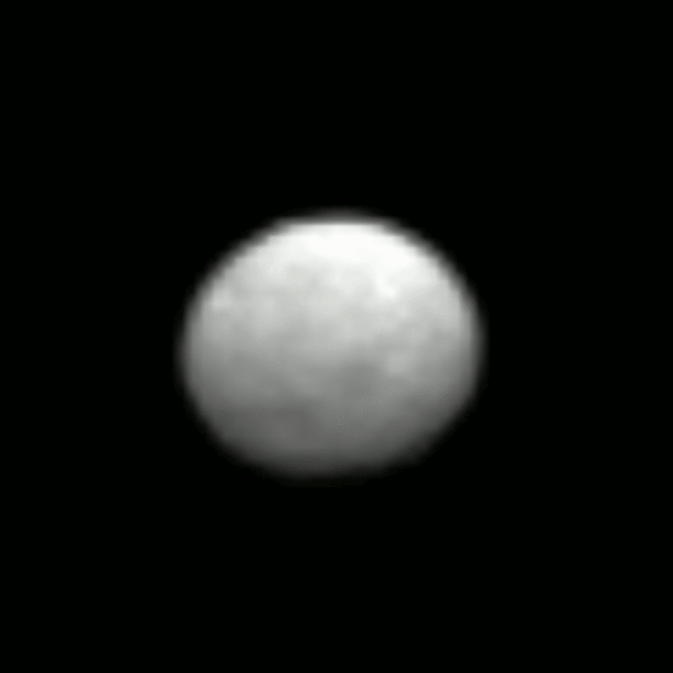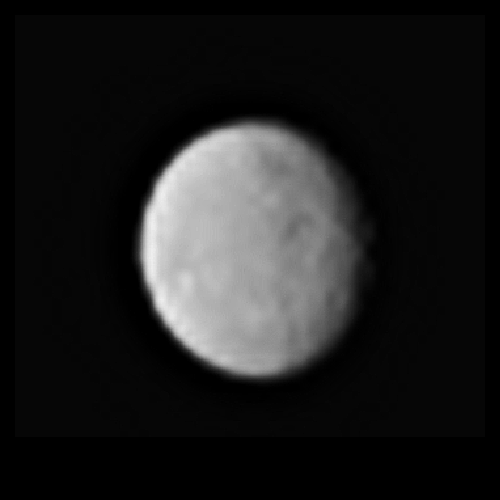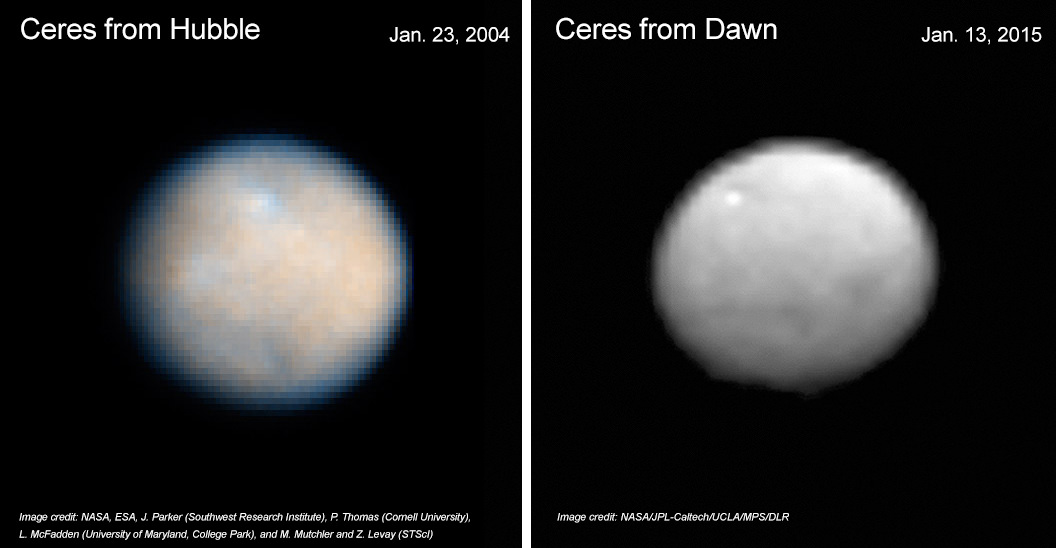There’s a big white spot on Ceres and we don’t know what it is. We’ve known about the white spot since the Hubble Space Telescope first captured images of it in 2003 and 2004, and in subsequent images taken by Hubble, the spot remains visible. Now, in images released yesterday from the Dawn spacecraft, currently on approach to Ceres, the spot remains. In the animated image, below, the spot almost seems to glint in the sunlight.
What is it?

One of the most anticipated aspects the Dawn spacecraft being in orbit around Ceres HAS to be finding out what this spot is. It could be ice, it could be a cryovolcano or geysers, or it could be something else. But we do know fairly certain that it is a real feature and not an image artifact, since it shows up in most of the recent Hubble images and now the Dawn images.
Planetary scientists have long suspected that water ice may be buried under Cere’s crust. A few things point to subsurface ice: the density of Ceres is less than that of the Earth’s crust, and because the surface bears spectral evidence of water-bearing minerals. Scientists estimate that if Ceres were composed of 25 percent water, it may have more water than all the fresh water on Earth. Ceres’ water, unlike Earth’s, would be in the form of water ice and located in the mantle, which wraps around the asteroid’s solid core.
And then last year, the Herschel space telescope discovered water vapor around Ceres, and the vapor could be emanating from water plumes — much like those that are on Saturn’s moon Enceladus – or it could be from cryovolcanism from geysers or icy volcanoes. Without huge a planet or satellite nearby tugging on it, the mechanism for how Ceres is active is also intriguing.

Some scientists also think Ceres may have an ocean and possibly an atmosphere.
As we discussed in our article yesterday, with all that water potentially at Ceres, could it theoretically host microbial life? Some scientists have hinted that Ceres and other icy bodies could be a possible source for life on Earth, another intriguing proposition.
Yesterday, I asked Dawn scientist Paul Schenk what other factors would have to be present in order for microbial life to have arisen on Ceres.
“The presence of carbon molecules is often regarded as necessary for life,” he replied, “and we think we see that on the surface spectroscopically in the form of carbonates and clays. So, I think the questions will be, whether there is actually liquid water of any kind, whether the carbon compounds are just a surface coating or in the interior, and whether Ceres has ever been warm. If those are true then some sort of prebiotic or biotic activity is in play.”
And we’ll soon find out more about this intriguing dwarf planet.

NASA/JPL-Caltech/UCLA/MPS/DLR/IDA
As the deputy principal investigator for Dawn, Carol Raymond said following the Herschel water vapor discovery, “We’ve got a spacecraft on the way to Ceres, so we don’t have to wait long before getting more context on this intriguing result, right from the source itself.”
NASA says that Dawn’s images will surpass Hubble’s resolution at the next imaging opportunity, which will be at the end of January.
The spacecraft arrives at Ceres on March 6, when it will be captured into orbit. The images will continue to improve as the spacecraft spirals closer to the surface during its 16-month study of the dwarf planet. Dawn will eventually be about 1,000 times closer to Ceres than it was for the images released yesterday and therefore will provide 1,000 times as much detail. Dawn at Ceres is primarily a mapping mission, so it will map the geology and chemistry of the surface in high resolution.
It should reveal the processes that drive the outgassing activity, and it should reveal how much water this dwarf planet holds.
And it should reveal the mystery of that white spot.


With 12 years of data I wonder if anyone can see the spot drift. Might be evidence of the crust moving around. I think they’ve seen this on Europa and Titan.
Links per the idea that if there is an ocean the crust might move around – http://phys.org/news125243334.html
http://phys.org/news/2014-09-faraway-moon-mimics-earth-tectonics.html
Not the same in each case but still, if there is an ocean that spot might move around. Like from the impact that made it (if it is an impact.)
Year of the Dwarf Planet, my foot! “Amazing Year of the Dwarf Planet.” A tiny telescope and camera is on Dawn but getting in close, it will do. Hopefully, the 2 remaining gyros will hold up. Remarkably bright object considering its not a matter of sun angle – glint, but just huge contrast to the rest of the dwarf planet. Interesting that the whole surface over time has not been covered with an icy cover from cryo-geysers or what may. Sublimation rate of water at Ceres probably would give some upper limit on the rate at which water is being expelled. Nice article!
Not necessarily that bright, as the images are likely auto-contrast-stretched. The brightest spot thus becomes white but doesn’t need to be actually white. Amazing anyway!
Yes. Thanks for reminding me. NASA engineers neglect a bit too often to fill in the public on such details and other features such as scale, direction, color modifications, etc. There is likely some stretching but who knows maybe not; providers need to state. Even with contrast stretching the difference between water-ice and the darkness of asteroid-type regolith is going to be very high.
“What is it?”
It could be water ice in a big , old (shallow) crater; ice volcano… !
I’ll wager that bright spot on Ceres is a fresh impact crater! It will be very interesting to see if the water ices on Ceres are more similar to Vesta’s water ices, or the Earth’s or to the water ices found by the Rosetta/Philae mission?
I’ll second that guess that it’s a fresh impact crater. I hope it is a cryovolcano though 🙂
I think you are right. Wonder if it has a big central peak too.
Ceres’ Tycho crater. IOW, a fresh impact is my guess.
what are the median impact and escape velocities for Ceres?
Earth impact V !median is about 20-25 km/s (11-72km/s range) and
Earth escape V ~11 km/s (Low orbit speed ~7km/s)
Sun Escape V 42 km/s at Earth Orbit (~30km/s orbit speed)
Pluto escape velocity is about 1.2 km/s
Pluto Assumed typical impact velocity ~2 km/s
Pluto Sun escape V ~7.7 km/s (~4.7 km/s orbit speed)
Escape velocity for Ceres is 0.51 km/sec according to Wikipedia. That’s about 1,100 mph.
hmm, orbital speed of Ceres is about 18 km/s so avg impact at 66% of that would be around 12 (to 15) km/s ….
Looks to me like Ceres is to small to accumulate matter through impacts. You would have to lose 96% of the energy to avoid anything escaping.
And sorry for bothering, I thought it would be easy to figure it out, but not for me.
Ceres could be covered in a darker coloured dust (like Mars) over water ice and the white spot is a recent impact crater exposing the white water ice beneath the dust….also if you look closely to the right of it there is another (not so) white spot probably an older impact where the resettled dust has taken some of the glare off it that’s my guess…..
Not going to even bother looking on Enterprise Mission dot com, but I’ll wager anyone 10 to one that Dick Hoagland’s crying, “Domed Alien City”! lmao! On the serious side though, would cryo-volc or impact cratering’s localized albedo effects last a decade? Anyone know?